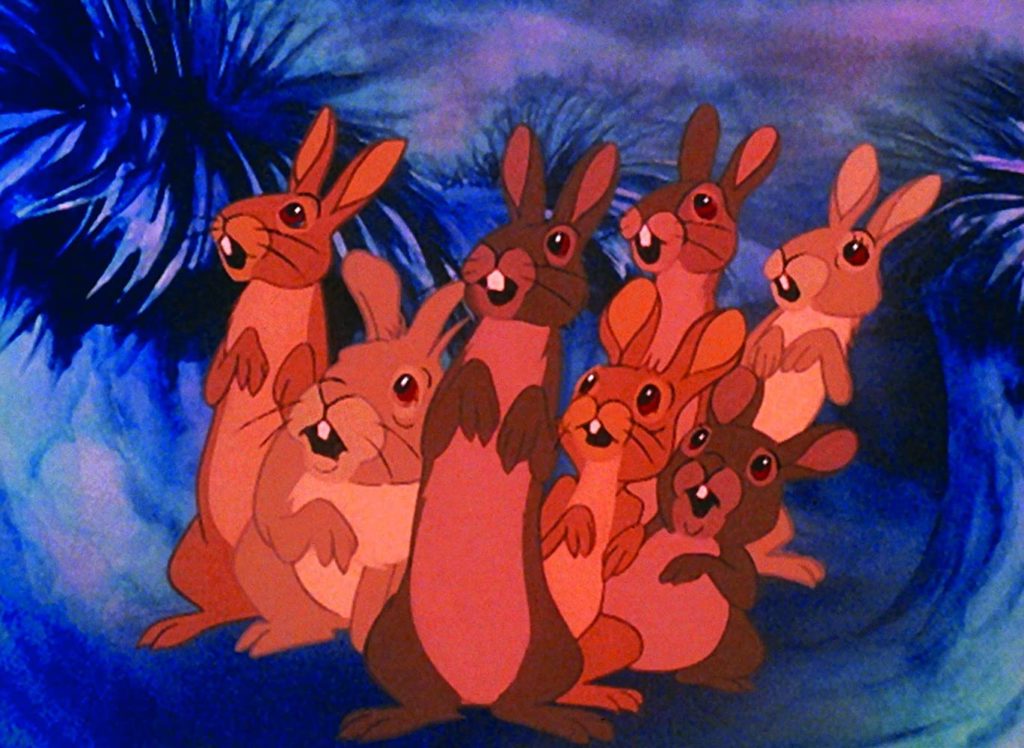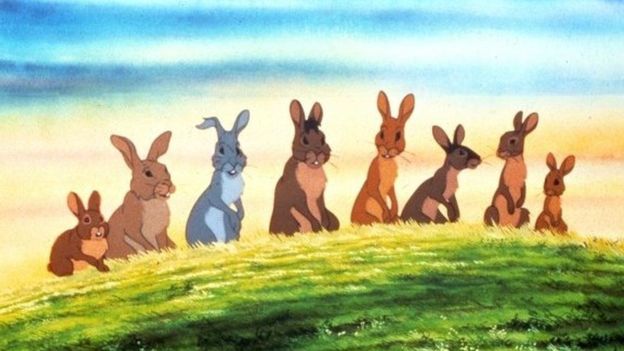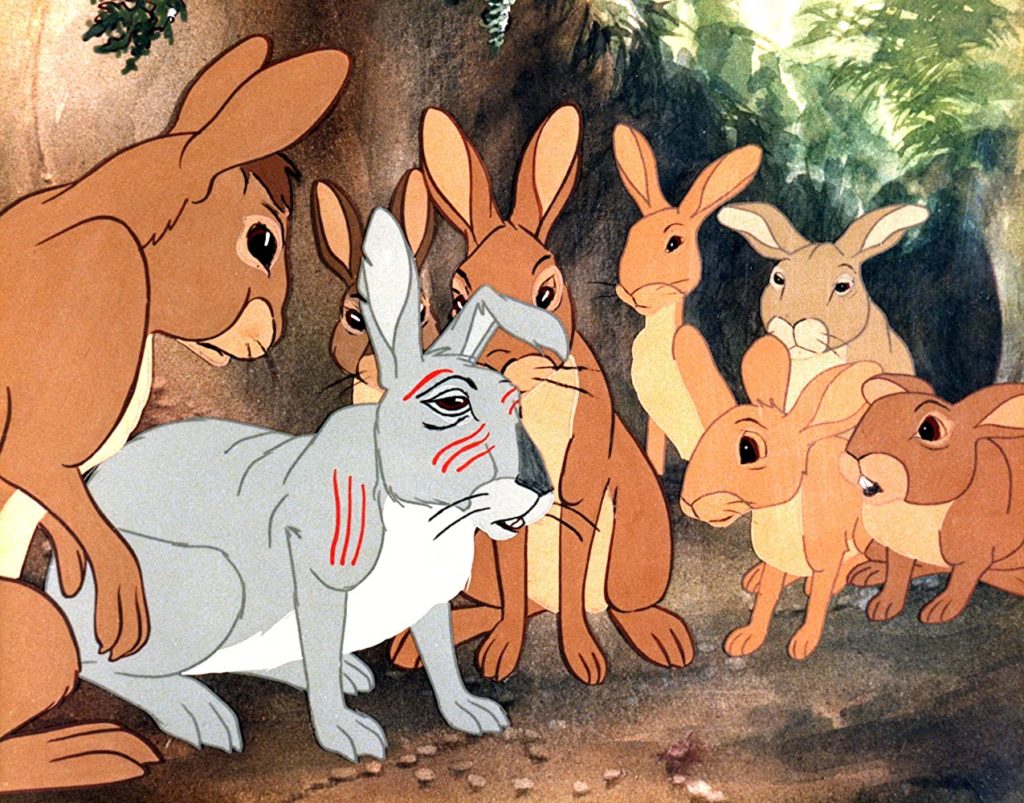A Fresh Look at a Dark Animated Classic.
DIRECTED BY MARTIN ROSEN/1978

“An animated rabbit holocaust movie,” was how Watership Down was introduced to me. I was attending a midnight screening of Mad Max at St. Louis’s Tivoli theatre in May 2015, and the presenter had, by their own admission, not seen the film. Rather, they were simply playing on the film’s infamy as a means of encouraging viewers to return, not necessarily without justification. Certainly, Watership Down employs some rather horrifying imagery that at times can unnerve adult audiences, let alone younger viewers.
However, Watership Down is far more than a mere curio, another checkmark to tick on the hundredth internet list cataloging “most nightmare inducing kid’s movies” and the like. It is an often haunting story that chronicles the story of creatures that spend their whole lives in the shadow of death, yet it manages also to be beautiful, joyful, triumphant, and even at times quite funny.
The film opens as the great Frith makes the animals of the forest, all rendered in a style which evokes Australian aboriginal drawing. Frith then proceeds to punish the trickster prince of the rabbits, El-ahrairah, for his hubris. As El-ahrairah flees from all those of the forest who seek to kill him, Frith delivers the monologue that would become the film’s tagline, before we transition to a beautifully rendered watercolor depiction of the English countryside.
From here, we are introduced to two rabbits, Fiver and Hazel, as frail Fiver is overcome by visions of blood coursing through the meadow. Hazel takes Fiver to the see the Chief Rabbit of their warren, but finds his concerns scoffed at and ignored. Still trusting in Fiver’s vision, the duo set off an odyssey to the far off hills and the warren that hopefully awaits them, joined by the strong yet simple Bigwig and a handful of other rabbits. Yet the seemingly bucolic English countryside is fraught with dangers, and the shadow of the Black Rabbit is a constant companion to them through the entirety of their journey.

Yet the shadow of death lingers even after they arrive at their new home, the eponymous Watership Down, as these refugees find themselves in conflict with the militant Efran warren and its leader, the cruel dictator General Woundwort. With only the gifts Frith bestowed upon El-ahrairah – and a bit of help from the seagull Keehar – the rabbits of Watership Down must use all their tricks and courage to try and find peace when all the world is their enemy.
Martin Rosen’s directorial debut, Watership Down, is an animated adaptation of Richard Adams’s bestselling 1972 novel of the same name. Rosen, using experience and connections from prior work as a producer, worked feverishly to create an animation studio that would allow the production of the film, so sure was he that animation was the only means to effectively craft an adaptation of Watership Down. This passion and dogged persistence is clearly visible in the finished piece, a love letter to Adams’s original text. The film takes great care to retain much of the novel’s mythological flavor and nuanced depictions of death, all while presenting a singular, entirely unique animated film. Watership Down is filled to the brim with captivating visuals, fabulous performances, and a soundtrack which perfectly complements the film’s scope.
The opening sequence, devised by Luciana Arrighi in cooperation with UPA alum and independent animator John Hubley, uses the aforementioned aboriginal styled renderings to depict the mythology of Watership Down’s rabbits. Even when describing the world as cruel and deadly to El-ahrairah and his descendants, the opening is gentle and cute, a fable meant for a small child. And then, we are thrust into the world as it truly is, immediately subject to Fiver’s visions of a river of blood flowing through the meadow, a sign that death can be found even in the picturesque countryside.

The remainder of the film is a visual marvel in its own right, particularly the gorgeously rendered watercolor backgrounds throughout and the woodcut style used in many shots of Cowslip’s warren. The rabbits are rendered in a fashion far from the “Funny Animals” style of Looney Tunes or Hanna-Barbera, but are still given recognizably human features that allow them to emote and act while never drifting into the uncanny. The more realistic renderings of the rabbits provide a level of grounding that aids the film’s treatment of death.
The frank depictions of death provide the audience with far greater insight into the terrifying world of a prey animal, while also managing to serve as a way to help younger viewers process death. Death is quick, random, often pointless and messy, but one shouldn’t mistake the film’s unwillingness to patronize its audience with it reveling in violence. Rather, death and violence are used to highlight the importance of continuing on, of mourning the lost and celebrating their memory, but still finding the courage and wherewithal to march onwards. Instead of casting a pall over the film, death’s frequent intrusions make the beautiful moments – the jokes shared among the rabbits, and the peace of Watership Down – all the more precious. The possibility, if not probability, that these rabbits could die engages the audience far more in their struggle for survival, providing an incredible dramatic weight that most other animated fables are unable to.
The film is given further grounding via the work of its impressive voice cast. For the most part performances are not “cartoony,” it largely avoids cutesy voices and dopey affectations. John Hurt’s Hazel imbues the role just as much warmth and commanding presence as he did Aragorn in 1978’s The Lord of the Rings, and Harry Andrews manages a powerful and imperious tone as General Woundwort without dipping into cartoonish snarling. The one exception is Zero Mostel’s Keehar, a heavily accented seagull and the film’s comic relief. Keehar’s strange manner of speaking only enhances his antics, which diffuse the tension of the journey to Watership Down in a way that makes the lead up to the final confrontation with Woundwort all the more impactful.

Watership Down’s soundtrack too is incredibly impactful, a powerful compliment to the rich visuals and performances. Art Garfunkel’s “Bright Eyes” is the most immediately recognizable piece from the film, and despite being a bit syrupy its minimalist nature lends itself excellently to the captivatingly dreamy sequence it’s paired with. However, Angela Morely’s less discussed score is essential, a perfect complement to the film. Morely, a highly accomplished composer and the first transgender woman to be nominated for an Academy Award, presents a grand, sweeping score that elevates the antics of rabbits to the stuff of myth, balancing the intensity of the rabbits’ quest with the beauty of the countryside they travel. And she managed to compose all of it in only two weeks.
Of course, for all its triumphs, Watership Down is not perfect. Technical errors abound with rough patches of animation cropping up throughout, most prominently with a cat that stalks the rabbits as they intrude on a farm. Coloring errors and inconsistencies in detailing, lack of depth in some backgrounds, and checking issues aren’t particularly uncommon either. Further, some of the depth of Adams’s text is lost or truncated in the transition to film, resulting in occasionally weak characterization.
However, Watership Down’s missteps and errors are fairly minor when matched against its achievements, and do little to detract from one’s enjoyment of the film. A wholly singular vision rendered lovingly by a team of incredible artists, all under the direction of a man who clearly adored the work he was adapting, Watership Down is a beautiful fable that I cannot recommend enough. Certainly it is available in a format worthy of its quality, an absolutely gorgeous remaster released as a part of the Criterion Collection, with a generous helping of supplements to further develop your appreciation for this film.

